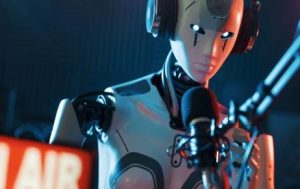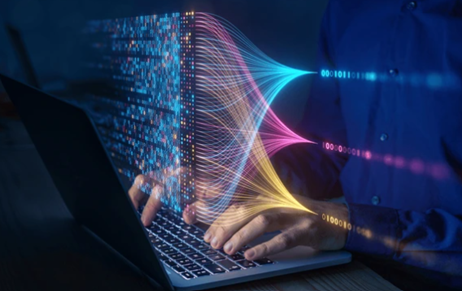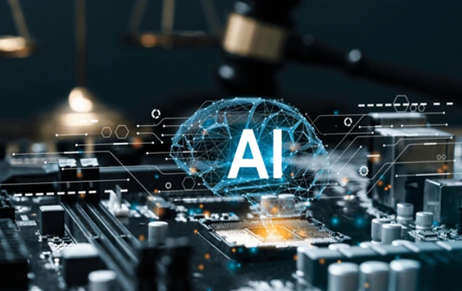In recent years, the world witnessed an exponential surge in the use of Artificial Intelligence…
AI Generated Music Composition: Fair Dealing Doctrine as an exception in India
Literature Review:
David Henkin[1]
In this article, the author has talked about how AI is used in a wide manner that creates extraordinary opportunities as well as challenges to the music composers and how its tools are used by various musicians to write, compose, record and mix music more effectively and creatively. The few AI powered Composing tools are Amper Music Songwriter, AIVA, Band-in-a-box and etc, which makes the work indistinguishable from a creator’s work which comes down to the question of authenticity and deep fakes. It is because AI doesn’t have the power to create something from scratch but to modify the existing work creatively. The author has failed to mention the fact that if Fair Dealing Doctrine has applied there can be minimal use of copyrighted material and since this is a process of deriving abstractions from the data, the abstractions are not copyrightable. Therefore an evolution of the existing music takes place and not the replica.
Matt Reynolds[2]
This article talks about the AI generated music and its legality. It mainly talks about the language model Claude that is used to generate music and whether it amounts to infringement or not. It has discussed the case laws which state that in the US the usage of the AI is not an infringement because it creates the output based on the abstract of the input. Here the author has failed to mention that the Abstractions here means the ideas, concept and the theme which are not copyrightable. And only when the ideas are given a form, through expression they are copyrightable and not ideas per se are not protected under copyright. So the AI generated work cannot be an infringement. And usually fair dealing allows the limited amount of usage of a copyrighted work if it’s for the purpose of parody, criticism and research.
Rajiv Sharma, Ninand Mittal[3]
This article talks about the authorship of the machine or owner of the machine for the works developed by it and has done a comparative analysis based on India, UK, Ireland and its prevalent that in Indian copyrights Act, even if the work is computer generated then the person who causes it will get the authorship whereas in UK and Irish law, there are specific provisions for computer generated without human skill employed. Here the author has not addressed whether AI copying the existing data is infringement or not and whether fair dealing can be used as an exception when it comes to AI as it is a computer generated programme and does not have the capacity of getting its work copyrighted.
Sufiya Ahmed[4]
In this paper the author examines the breadth and depth of the doctrine of fair dealing through examination of both national and international legal frameworks, as well as judicial interpretations. In detail she discusses copyright and the historical evolution of copyright law in India. The author asserts that copyright law does not focus on the originality of ideas but rather on the expression of those ideas. To be eligible for protection under copyright law, a work mst be original in the sense that the author has crafted it through their own skill, effort, and discernment. The origin and evolution of fair dealing are examined, along with an exploration of the distinctions between fair dealing and fair use. The author also delves into the concept of fair dealing as it pertains to digital works within the paper.
Prashant Rahangdale[5]
In this paper various provisions related to fair dealing under Indian copyrights law are discussed by the author. The paper delineates various types of copyright infringements along with the concept of fair dealing and the difference between fair dealing and fair use. The author provides a detailed discussion of Section 52 of the Indian Copyright Act in the paper. The author further concludes the paper by stating that It’s understandable to see the difference in the approach to limitations on copyright between the US and Indian copyright laws. The flexibility in US copyright law allows for a more adaptable framework that can accommodate evolving technologies and cultural practices. On the other hand, the Indian Copyright Act, especially with the amendments to section 52 that made it more rigid, may seem less accommodating.In a developing nation like India, where access to knowledge and cultural expression is crucial for progress, a more flexible approach to fair dealing provisions could indeed be beneficial. Open-ended provisions could allow for a broader range of uses that promote education, innovation, and creativity without unduly restricting access to copyrighted works. Robust stakeholder engagement is necessary, involving legal experts, musicians, AI developers, policymakers, and industry representatives, to tackle challenges and formulate well-informed policies that strike a balance among the interests of all involved parties and these necessities are not mentioned or discussed in the paper
Mansi Kapoor[6]
This article explores the conditions under which AI-generated music may breach copyright laws, particularly when the system replicates the style of an artist. Additionally, it delves into whether such music could be eligible for protection under the fair dealing doctrine. The article talks about what an AI is and how it is used to compose music. The author discusses how copyright protects AI creations and he also compares how AI creations are protected by copyright in various countries like the UK, US, Australia etc.. The author further concludes by stating that AI-generated content requires attention for policy inclusion within the legal framework of countries. It prompts the need to determine if rights can be claimed against AI-generated material in cases of copyright infringement, and the subsequent accountability. Currently, there is a lack of consensus among nations regarding the extent and level of protection to be afforded to AI-generated works. their national laws.
Piyush Senapati[7]
In this paper the author fails to address the lack of legal clarity, India’s copyright lacks explicit provisions addressing AI-generated content, leading to uncertainty regarding the application of fair dealing principles to music compositions produced by AI systems legislations lacks explicit provisions addressing AI-generated content, leading to uncertainty regarding the application of fair dealing principles to music compositions produced by AI systems. T.The author states that In the paper there is hardly the mention of the absence of dedicated policies and guidelines tailored to AI-generated content in India leading to a policy vacuum. This gap impedes the establishment of clear legal frameworks and practical guidelines for addressing copyright issues concerning AI-generated music compositions.
ABSTRACT:
This paper delves into the issue of how fair dealing doctrine can be applied and used as an exception when it comes to AI generated music composition in accordance with Indian Copyright Act, 1957. With AI being used almost everywhere, there has been an increase in the utilization of the synthetic media in terms of creating and producing music which leads to the rise of questions such as copyright infringement and fair dealing. By analyzing, comparing and examining the current legal provisions, relevant case laws and related policy developments this paper aims to provide a clear cut clarity on the permissible usage of copyrighted work in AI generated music as well as ensuring the protection of Intellectual Property Rights of the Author.
INTRODUCTION:
The increasing use of Artificial Intelligence (AI)[8] technology has not only revolutionized the autistic works but also the music industry. It enables and enhances the composition of music in a very simple, easy and a cost efficient manner which is autonomous as it is generated by algorithms. The more positive impacts, there are also negative impacts which has led to debates regarding copyright ownership as to whether the author’s work is infringed and the ambit of the fair dealing doctrine that is used as an exception to the infringement. Intellectual Property Rights in terms of India is evolving from time to time understanding the application of the fair dealing doctrine to AI generated music is an essential step in promoting innovation while safeguarding the creator’s rights.
METHODOLOGY:
The methodology used for this research is a qualitative research method that focuses on deeply examining and comprehending complex phenomena , it is only concerned with non numerical data. It is done by conducting a literature review of existing journals and articles on fair dealing, copyright law, and AI generated music composition related topics and also by examining the Indian copyright law provisions to know about the legal framework by which the music compositions and Intellectual property rights are governed also by identifying provisions related to fair dealing and fair use in copyright.
OBJECTIVES:
- To Examine India’s current copyright legislation and fair dealing regulations and to determine whether AI generated music compositions can benefit from them
- To determine the main obstacles and areas of uncertainty when implementing fair dealing rules to music compositions created by AI in the context of Indian Law
- To suggest useful guidelines on how to handle copyright regulation and fair dealing rules for composers and users of AI generated music
LIMITATIONS:
This paper aims to offer a proper examination of fair dealing in AI-generated music composition, however:
- The evolution of copyright law and AI technologies can influence the applicability of findings and recommendations over time.[9]
- The lack of the number of case laws and legal precedents pertaining to AI generated music in India could constrain the depth of analysis
- The interaction between technological advancements, legal framework and ethical considerations may act as obstacles in devising policies.
ANALYSIS:
In The Indian Copyright Act, 1957[10] there are few important provisions related to this paper. Where section 13[11] provides copyright protection and on what it can be given, section 14[12] where the economic rights are granted to a copyright holder, section 51[13] provides the grounds for infringement whereas 52[14] contains the provision for fair dealing and the purposes for which this exception can be applied. While fair dealing exceptions include many factors, a complete transformation of the work takes place for AI generated music. Emphasizing transformation provides considerable flexibility for AI musicians and developers in usage of the copyrighted work without infringement as long as the output exhibits significant divergence from the originals.

The case of Civic Chandran v. Ammini Amma[15] sets a foundational guideline for the determination of fair dealing exception in copyrighted works considering factors such as the quantum of materials used, the purpose and the distinguishability of the new work from the original one. Crucially it emphasizes on the transformative nature of the new work on the basis of how it is expressed, its character and the meaning from the original despite using substantial portions of the original work. The emphasis on transformation is derived from American[16] copyright jurisprudence.
When it comes to AI generated music, it can potentially qualify for a fair dealing exception when it has altered the original work in a significant manner by making the expressive elements very distinctive. Arrangement style that the AI employs also amounts to transformation.
For figuring out the transformation Listeners test can be conducted which is similar to the Viewers test that was established in the case of R.G Anand v. Delux Films[17]. The objective of the viewers test is to see whether an average viewer having heard and watched both the works has an impression that the subsequent work is the copy of the original. And if it is then the infringement comes into the picture but here in the listeners test if the listener has an impression that the subsequent work has mere or no connection to the original work then the transformation has taken place.
SUGGESTION:
The existing copyright laws can be amended to address the copyright status and ownership of AI generated music along with fair compensation mechanisms for both traditional musicians and AI developers models such as compulsory licensing should be explored.[18] Clear guidelines on how copyright protection applies on AI generated music should be provided. Transparency in the creation and distribution of AI generated music including disclosure of AI algorithms is required. Educational and awareness programmes among the musicians can also be implemented.
CONCLUSION:
In spite of these drawbacks this study adds to the current discourse about fair dealing and AI generated music competition in India. This paper attempts to create a balanced approach to copyright protection and innovation in the music industry by offering insights to legal situations, identifying challenges and recommending policy action.
Author: Varshini VS, in case of any queries please contact/write back to us via email to chhavi@khuranaandkhurana.com or at IIPRD.
[1] David Henkin, Orchestrating the future-AI in the music industry Forbes (2023), https://www.forbes.com/sites/davidhenkin/2023/12/05/orchestrating-the-future-ai-in-the-music-industry/?sh=4044463b4f64 (last visited Apr 14, 2024).
[2] Matt Reynolds, AI-generated music is everywhere; is any of it legal? ABAJOURNAL (2024), https://www.abajournal.com/web/article/ai-generated-music-is-everywhere-is-any-of-it-legal (last visited Apr 14, 2024).
[3] Rajiv Sharma & Ninad Mittal, Artificial intelligence lacks personhood to become the author of an intellectual property Live Law (2023), https://www.livelaw.in/law-firms/law-firm-articles-/artificial-intelligence-intellectual-property-indian-copyright-act-singhania-co-llp-238401 (last visited Apr 15, 2024).
[4] Sufiya Ahmed, Fair dealing in Indian copyright law NIScPR Online Periodical Repository: Home (2021), https://nopr.niscpr.res.in/handle/123456789/58020 (last visited Apr 16, 2024).
[5] Prashant Rahangdale, Fair dealing limitation to copyright SSRN (2020), https://papers.ssrn.com/sol3/papers.cfm?abstract_id=3606890 (last visited Apr 16, 2024).
[6]Mansi Kapoor, Al-generated music and copyright law S.S. Rana & Co. (2024), https://ssrana.in/articles/al-generated-music-and-copyright-law/ (last visited Apr 16, 2024).
[7] Piyush Senapati, When machines become musicians: Exploring the copyright infringement implications of ai-generated music The IP Law Post (2023), https://iplawpost.wordpress.com/2023/08/03/when-machines-become-musicians-exploring-the-copyright-infringement-implications-of-ai-generated-music/ (last visited Apr 16, 2024).
[8] Kristalina Georgieva, Ai will transform the global economy. let’s make sure it benefits humanity. IMF (2024), https://www.imf.org/en/Blogs/Articles/2024/01/14/ai-will-transform-the-global-economy-lets-make-sure-it-benefits-humanity (last visited Apr 16, 2024).
[9] Esther Ajao, Fair use may not help anthropic against AI Music Lawsuit: TechTarget Enterprise AI (2023), https://www.techtarget.com/searchenterpriseai/news/366556341/Fair-use-may-not-help-Anthropic-against-AI-music-lawsuit (last visited Apr 16, 2024).
[10] Copyright Act, No. 14 of 1957, § 14, Acts of Parliament, 1957 (India).
[11] Copyright Act, 1957, § 13.
[12] Copyright Act, 1957, § 14.
[13] Copyright Act, 1957, § 51.
[14] Copyright Act, 1957, § 52.
[15] Civic Chandran v. Ammini Amma, 1996 CriLJ 3938
[16] Bridgeport Music, Inc. v. Dimension Films, 383 F.3d 390 (6th Cir. 2004).
[17] R.G. Anand v. Delux Films, (1978) 2 SCC 202.
[18] Eric Sunray, Copyright infringement in AI Music Generator outputs Sounds of Science (2021), https://scholarship.law.edu/cgi/viewcontent.cgi?article=1108&context=jlt (last visited Apr 15, 2024).



